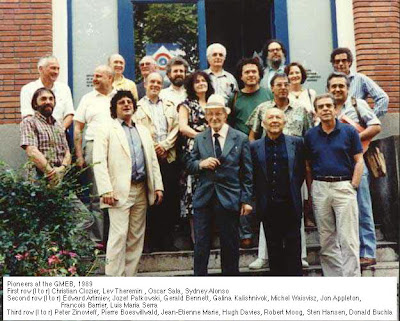via Fabricio Carvalho on The MATRIXSYNTH Lounge
 "David was one of the main [people] responsible for the Mini Moog becoming a very popular instrument in the early seventies, when he decided to travel thru the USA demonstrating and selling the instrument. David Van Koevering was also the developer of the Orchestron, an instrument that was based on Mattel's Optigan, that became very famous when musicians like Patrick Moraz and Kraftwerk members used in their records!"
"David was one of the main [people] responsible for the Mini Moog becoming a very popular instrument in the early seventies, when he decided to travel thru the USA demonstrating and selling the instrument. David Van Koevering was also the developer of the Orchestron, an instrument that was based on Mattel's Optigan, that became very famous when musicians like Patrick Moraz and Kraftwerk members used in their records!"You'll find the interview on Astronauta Pinguim here.
Pictured:
Top: "On stage: David Van Koevering (2nd from left) and Robert Moog (seated)."
"ASTRONAUTA - How did you meet Robert Moog for the first time?
DAVID - I was traveling and doing musical educational programs in the public schools. There is a picture of my educational presentation in Trevor Pinch's book "Analog Days". I saw an ad in the Music Educators Journal that had a photo of the R. A. Moog Studio in Trumansburg, NY which said "Come Visit Our Backroom". I was performing in the area and decided to visit. Bob Moog was in Europe so I did not meet him then. Awhile later I was performing at a school in Long Island, NY and the principal said "I want you to meet Bob Moog". He had come from Trumansburg, NY to meet me and see and hear my show. Bob and I talked about the last song on my show where I performed on a "Theremin". I had made it from and article that Bob had published in an electronics magazine. After meeting Bob that day he asked if I would like to join him and his family at Carnegie Hall in New York City. It was the first ever live performance of the "Moog Quartet" with Gershon Kingsley. During that concert something switched on in my spirit, I knew I needed to be involved! I had a huge audience and showing the future of music to the younger generation became my goal."
Left: David Van Koevering with Moog theremin.
www.davidvankoevering.com



































































